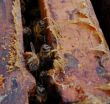(Press-News.org) London -- Russians born during the Leningrad Siege in World War II, which was responsible for some of the greatest losses of civilian life in history, are giving scientists new strategies to identify people who experienced intrauterine growth restriction (IUGR) and starvation during childhood at greatest risk of developing long term heart complications. The abstract study¹, presented at the Frontiers in CardioVascular Biology (FCVB) meeting, in London, UK, 30 March to 1 April 2012, makes use of a unique population of people exposed to extreme starvation both as foetuses and during childhood.
The cellular changes identified, investigators suggested, might be used to target treatments to children at greatest risk of developing heart complications. In a second study ², also presented at FCVB 2012, Spanish investigators elucidated structural changes occurring in the heart as a direct consequence of IUGR. Monitoring reversal of these changes, suggested the authors, might offer a "fast track" approach for testing effectiveness of new therapies.
"Together, these innovative studies demonstrate the impact that basic research can have on the development of new approaches to heart treatments," said Sian Harding, FCVB 2012 chairperson of the Core Scientific Committee. "New treatments preventing heart changes associated with poor nutrition would benefit those exposed to IUGR and also children who've experienced reduced calorie intakes, either due to food shortages or extreme dieting."
Intrauterine growth restriction (IUGR), defined as a birth weight below the 10th percentile for gestational age, currently has an incidence estimated to be 8.1% of births in developed countries, and 6 to 30% of births in developing countries. Common causes include chronically malnourished mothers, maternal health problems during pregnancy (such as diabetes) and placentas that fail to transfer adequate nutrients from mother to foetus.
The connection between IUGR and development of subsequent heart disease was first recognised in 1989 when David Barker, from the MRC Unit at the University of Southampton, UK, showed that the lower the weight of a baby at birth and during infancy, the higher the risk of developing cardiovascular disease (CVD) and other chronic conditions in later life ³. IUGR newborns show signs of CV remodelling and dysfunction, including reduced myocardial velocities, dilated hearts and increased thickness of artery walls.
Studies have shown that children with IUGR have a distinct cardiac morphology, with "less elongated and more globular" cardiac ventricles. "As a consequence IUGR hearts are not as efficient in generating the normal stroke volumes, which results in the need for an increased heart rate to maintain cardiac outputs. The overall result is less efficient hearts," explained Iratxe Torre, one of the investigators, from The Hospital Clinic of Barcelona, Spain.
No treatments are currently available to reverse the structural heart changes resulting from IUGR.
Telomere length provides CVD insights in survivors of Leningrad Siege.
In abstract P190 investigators from the Almazov Federal Heart, Blood and Endocrinology Centre, St Petersburg, Russian Federation, studied the telomere length of survivors from the siege of Leningrad (1941 to 1944), which was responsible for citizens being subjected to some of the most extreme levels of starvation known in history ¹.
"For workers the bread ration was 250g, which amounted to just 300 calories, with around half that for the rest of the population," said Olga Freylikhman, one of the study investigators. The diet, she added, contained virtually no protein. By the end of the siege out of a population of 2.9 million, including 0.5 million children, over 630,000 people had died from hunger related causes.
Telomeres are the DNA-protein complexes that encase the ends of chromosomes. Often likened to the plastic caps on shoelaces, they serve the function of promoting chromosome stability. Consistently shortened telomere lengths have been associated with health risk and disease - one study showed that mean telomere lengths (measured in blood DNA) predicted the 15 year risk of CVD mortality, and others identified shorter telomeres among subjects who smoked, had elevated blood pressure, and premature myocardial infarctions (MIs).
Identification of survivors for the study was made possible by the fact that after World War II, inhabitants of Leningrad (now St Petersburg) who survived the siege were invited to join special support societies. From these societies, still in existence today, investigators have been able to recruit 40 subjects born during the siege, and 260 born before the siege who had lived through the deprivations as children. Survivors were compared to age matched controls born during the same period (1930 to 1943) and now living in St Petersburg, but who had not been exposed to siege conditions. All subjects were asked to fill in questionnaires regarding lifestyle factors and take part in a range of tests including blood pressure measurements, fasting lipids and glucose tests, carotid ultrasound, arterial stiffness, and cognitive function, as well as measurements of their telomere lengths by quantitative PCR.
While measurements of telomere length for all subjects are now in progress, preliminary results (presented in the abstract) comparing the telomere length of survivors of the siege (n=106), with controls (n=27) show that survivors had significantly shorter telomere lengths (p END
Starvation linked to greater risk of cardiac complications
2012-04-02
ELSE PRESS RELEASES FROM THIS DATE:
Clocking an accelerating universe: First results from BOSS
2012-04-02
Some six billion light years ago, almost halfway from now back to the big bang, the universe was undergoing an elemental change. Held back until then by the mutual gravitational attraction of all the matter it contained, the universe had been expanding ever more slowly. Then, as matter spread out and its density decreased, dark energy took over and expansion began to accelerate.
Today BOSS, the Baryon Oscillation Spectroscopic Survey, the largest component of the third Sloan Digital Sky Survey (SDSS-III), announced the most accurate measurement yet of the distance scale ...
Benefits of taking Fido to work may not be far 'fetched'
2012-04-02
RICHMOND, Va. (March 30, 2012) – Man's best friend may make a positive difference in the workplace by reducing stress and making the job more satisfying for other employees, according to a Virginia Commonwealth University study.
Stress is a major contributor to employee absenteeism, morale and burnout and results in significant loss of productivity and resources. But a preliminary study, published in the March issue of the International Journal of Workplace Health Management, found that dogs in the workplace may buffer the impact of stress during the workday for their ...
Volcanic plumbing exposed
2012-04-02
Two new studies into the "plumbing systems" that lie under volcanoes could bring scientists closer to predicting large eruptions.
International teams of researchers, led by the University of Leeds, studied the location and behaviour of magma chambers on the Earth's mid-ocean ridge system - a vast chain of volcanoes along which the Earth forms new crust.
They worked in Afar (Ethiopia) and Iceland - the only places where mid-ocean ridges appear above sea level. Volcanic ridges (or "spreading centres") occur when tectonic plates "rift" or pull apart. Magma (hot molten ...
Some corals like it hot: Heat stress may help coral reefs survive climate change
2012-04-02
A team of international scientists working in the central Pacific have discovered that coral which has survived heat stress in the past is more likely to survive it in the future.
The study, published today in the journal PLoS ONE, paves the way towards an important road map on the impacts of ocean warming, and will help scientists identify the habitats and locations where coral reefs are more likely to adapt to climate change.
"We're starting to identify the types of reef environments where corals are more likely to persist in the future," says study co-author Simon ...
The electronic nose knows when your cantaloupe is ripe
2012-04-02
Have you ever been disappointed by a cantaloupe from the grocery store? Too ripe? Not ripe enough? Luckily for you, researchers from the University of California, Davis might have found a way to make imperfectly ripe fruit a thing of the past. The method will be published on March 30 in the Journal of Visualized Experiments (JoVE).
"We are involved in a project geared towards developing rapid methods to evaluate ripeness and flavour of fruits," said paper-author Dr. Florence Negre-Zkharov. "We evaluated an electronic nose to see if it can differentiate maturity of fruit, ...
The link between fast food and depression has been confirmed
2012-04-02
According to a recent study headed by scientists from the University of Las Palmas de Gran Canaria and the University of Granada, eating commercial baked goods (fairy cakes, croissants, doughnuts, etc.) and fast food (hamburgers, hotdogs and pizza) is linked to depression.
Published in the Public Health Nutrition journal, the results reveal that consumers of fast food, compared to those who eat little or none, are 51% more likely to develop depression.
Furthermore, a dose-response relationship was observed. In other words this means that "the more fast food you consume, ...
ADHD is over-diagnosed
2012-04-02
What experts and the public have already long suspected is now supported by representative data collected by researchers at Ruhr-Universität Bochum (RUB) and University of Basel: ADHD, attention deficit hyperactivity disorder, is over-diagnosed. The study showed that child and adolescent psychotherapists and psychiatrists tend to give a diagnosis based on heuristics, unclear rules of thumb, rather than adhering to recognized diagnostic criteria. Boys in particular are substantially more often misdiagnosed compared to girls. These are the most important results of a study ...
Whether grasping Easter eggs or glass bottles – this robotic hand uses tact
2012-04-02
It may be difficult to imagine, but pouring juice into a plastic cup can be a great challenge to a robot. While one hand holds the glass bottle firmly, the other one must gently grasp the cup. Researchers at Saarland University together with associates in Bologna and Naples have developed a robotic hand that can accomplish both tasks with ease and yet including the actuators is scarcely larger than a human arm. This was made possible by a novel string actuator, making use of small electric motors to twist strings. The robotic hand is thus powerful yet delicate and could ...
Intec Controls Inc. Selects SAP Business One from ProjectLine Solutions as its Integrated Business Management Solution to Propel Growth
2012-04-02
ProjectLine Solutions Inc. (www.projectline.ca), a leading provider of business enterprise and software solutions for small and mid-sized businesses, announces Intec Controls Inc. as one of its newest customers implementing the SAP Business One application. With offices across Western Canada, ProjectLine Solutions will be completing the implementation from its Saskatoon, SK office.
Based in Saskatoon, Intec Controls Inc. (www.inteccontrols.ca) represents a number of leading product lines in Saskatchewan and Manitoba from globally recognized manufacturers. In addition ...
Bees 'self-medicate' when infected with some pathogens
2012-04-02
Research from North Carolina State University shows that honey bees "self-medicate" when their colony is infected with a harmful fungus, bringing in increased amounts of antifungal plant resins to ward off the pathogen.
"The colony is willing to expend the energy and effort of its worker bees to collect these resins," says Dr. Michael Simone-Finstrom, a postdoctoral research scholar in NC State's Department of Entomology and lead author of a paper describing the research. "So, clearly this behavior has evolved because the benefit to the colony exceeds the cost."
Wild ...


